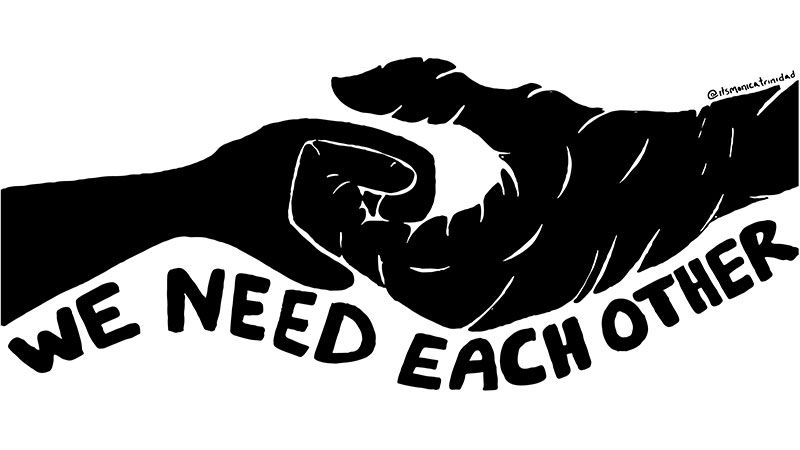In this article Edel answers the question: ‘what is mutual aid?’ She explains how people have worked together in many different contexts to meet needs in their communities both in the past, and under the current pandemic. In this she makes a case that our movements and organisations must always be based on horizontal care outside of just the state and charities, in order to build our capacity to change the world around us.

Mutual aid is an explicitly participatory form of care; people see needs not being met in their communities and come together to meet these needs in a concrete manner. They do not wait for those in power to take action. Activist and academic Dean Spade explains that mutual aid projects work “…not just through symbolic acts or putting pressure on their representatives in government, but by actually building new social relations that are more survivable.” At their core, mutual aid projects encourage people to exercise agency over their own lives and communities. It is genuinely empowering and goes beyond just representation. As writer Cate Root notes in Current Affairs, “regular people act, and not just act, but make decisions about how best to help. Mutual aid puts the power back into ordinary people’s hands.” Spade offers a framework for evaluating mutual aid campaigns; it must offer material relief for people, include impacted groups and ultimately mobilize those most affected for ongoing struggle.
Mutual aid is not a new concept. Mutual aid as we know it is often attributed to the Russian philosopher Peter Kropotkin. In 1902 he published his series of essays Mutual Aid: A Factor of Evolution. Kropotkin’s work complicated the Darwinian idea of the survival of the fittest. We are told again and again that competition for resources is how things must work. Kropotkin notes, “the abundance of facts of mutual aid, not only for rearing progeny, as recognized by most evolutionists, but also for the safety of the individual, and for providing it with the necessary food. With many large divisions of the animal kingdom mutual aid is the rule.” Despite the prevailing ideas of intrinsic human and animal selfishness, many contemporary scientists have observed that Kropotkin’s work holds true: many animals do actually engage in mutual aid – the most famous being ants.
Mutual aid has existed for a very long time, often under different names. Both enslaved and freed black people across 18th and 19th century America participated in mutual benefit groups and organizations. Many enslaved black people participated in community farming on Sundays. Early forms of such societies provided care for the sick, burials and support for orphans and widows. Later groups sought to promote education and job training, especially for fugitive slaves. Since then, recessions, climate catastrophes, Black Lives Matter and countless other crises and systemic inequalities have led to innumerable examples of mutual aid worldwide.
One of the most famous examples of mutual aid was the Black Panthers’ Free Breakfast Programme which was started in 1969. The programme was incredibly effective and by the end of the year was feeding an estimated 20,000 children. The state eventually copied it in order to neutralize wider support for the Panthers. As Cate Root notes, due to this co-option, now “…the state maintains control of how well breakfasts are funded, whether the program is subject to austerity measures, who qualifies for a free breakfast, and importantly, who ends up at the same table and what they might talk about.” In the 1970s, the Young Lords (a movement dedicated to the neighbourhood empowerment and self-determination of Puerto Rican and Latino communities) ran free school breakfasts, community testing for tuberculosis and lead-poisoning, a free health clinic, free dental clinic, community day care and a “Garbage Offensive” to help clean up Puerto Rican neighbourhoods neglected by city ran sanitation. Other forms of mutual aid include disaster relief, accompanying people to medical appointments, to welfare offices or escorting people who are in need of abortions. In Ireland, both housing movements and the Repeal campaign have led to examples of mutual aid. Since 1983, feminists have participated in forms of solidarity and mutual aid work through which they facilitated travel for abortions between Ireland and the UK. Stalls and hotlines shared information on accessing abortion services across Ireland. The Irish Women’s Abortion Support Group, an Irish women’s collective in London, ran an information line, organised appointments for women at abortion clinics, and negotiated with clinics about prices. They also met those looking for abortions upon their arrival in England, and even allowed them to stay overnight in their homes, and sometimes provided childcare. In Dublin, housing activists turned empty buildings into accommodation for those in need.
Since the beginning of the pandemic, the term mutual aid has grown both in visibility and popularity. Major newspapers have written long-form pieces on mutual aid and quoted Kropotkin. This renewed interest in mutual aid brings the danger of the meaning of mutual aid being diluted or corporatized. Words like empowerment have been rendered almost meaningless and can often be nothing more than a corporate buzzword. During the ongoing crisis, a Los Angeles wholesale food company, Cheetah, provided four fridges stocked with free food. Cheetah was last valued at 180 million dollars. They were inspired by existing examples of mutual aid, and a company spokesperson stated that “we wanted to figure out some sort of way to get [food waste] down to zero, and that’s how we thought of the fridge campaign.” While encouraging others to do the same, Cheetah stocks the fridge once a week with its surplus food. However, the company does not cover the electricity costs. Cheetah has also branded these fridges with a Cheetah logo in order to advertise the company’s wholesale prices. Mutual aid is in danger of becoming just another PR pawn for big companies.
It is also important to note the crucial distinction between charity and mutual aid. Mutual aid should be understood as solidarity and not as charity. This idea is inspired by Uruguayan writer Eduardo Galeano,“I don’t believe in charity. I believe in solidarity. Charity is so vertical. It goes from the top to the bottom. Solidarity is horizontal. It respects the other person. I have a lot to learn from other people.” Charity has its limits. Charity can professionalize the solutions to community problems, and often these solutions are constrained by a corporate structure which relies on wealthy donors and patrons. Thus, the most marginalized have little say in what their communities need.
For hundreds of years, damaging ideas of the deserving vs the undeserving poor have shaped who qualifies for help across the world. For instance, in Northern Ireland during parts of the 19th and 20th centuries, the concept of the deserving and undeserving poor was central to welfare provision. The respectable poor such as the elderly and disabled were regarded as deserving of sympathy and relief, while those lacking in “respectability” such as sex workers or people living on the streets were seen as deserving punishment instead of assistance. Their situations were seen as a result of a moral failing, and many were seen as innately feckless or lazy drunks who were content to leech off “good” society. This line of thinking led to assistance being slashed in order to “motivate” those in need to work. These ideas still persist, for example through the idea that a “respectable” person with a job and a house who loses it all and thus becomes homeless is more deserving of respect and empathy than a person who has been unhoused in the long term.
There is a common narrative that disasters ultimately reveal how selfish humans intrinsically are. It brings to mind a post-apocalyptic world where we would fight each other for the last tin of food. It is true that the pandemic has highlighted the worst failures of the world as we know it.
When how dire the pandemic could be became clear last Spring, hoarding and profiteering flourished. Masks and sanitizing products were sold at grossly inflated prices. The pandemic has also seen far-right anti-mask protests, workers being pushed into even more dangerous and inhumane working conditions, illegal evictions and ever increasing anti-Asian racism. However, the pandemic has also demonstrated amazing displays of real solidarity and mutual aid. In the UK, a report from the New Local Government Network claims that mutual aid groups have had a bigger impact than government-backed volunteering schemes, many of which were too slow moving. An open source website lists numerous international mutual aid networks, and artists in Thailand offered to make posters and graphics for free for mutual aid groups internationally. In Ireland during this second lockdown, multiple social media groups sprung up organizing the collection and distribution of PPE, sanitizer, supermarket vouchers and school supplies for those living in direct provision, with input from residents as to what they needed. An Indian family living in direct provision in Cork city made and distributed 2,000 masks, both to residents in their direct provision centre and to people in the city centre. Dublin based members of CATU have set up mutual aid schemes during recent months. Both the Crumlin-Drimnagh branch and the Inchicore-Kilmainham branch have been involved in ongoing mutual aid efforts. These networks have offered assistance with food shopping, prescriptions and wellness check phone calls to those who are isolated or vulnerable.
Mutual aid can be imperfect and if precautions are not taken, it can lead to the participants becoming burnt out. At its best, mutual aid builds real solidarity. Writer Samuel Miller McDonald argues that solidarity should be used as a strategic tool: “while spontaneous displays of solidarity are encouraging, these kinds of bonds will need to be sustained long-term, outside the street battles, if they are to hold workers together. The real difficulty in building class solidarity in the midst of a militarized, laissez-faire, social Darwinian culture has been woefully underestimated.” Miller McDonald also notes that “some of the first mass movements of the modern era, like those for abolition, women’s suffrage and labor rights, started with solidarity between members; it wasn’t an afterthought. The causal relationship didn’t go ‘movement, then solidarity.’ It was the reverse. Solidarity was the genesis.”
Spade describes mutual aid as the “radical act of caring for each other while working to change the world,” and as the pandemic brings heightened economic downturn and exacerbates existing systemic problems, mutual aid is more important than ever before. As of last year, 689,000 people in Ireland live in poverty, deaths of unhoused people are increasing, residents of direct provision are still denied basic dignity, illegal evictions continue and the pandemic further worsens the quality of life for vulnerable people.
Resources:
Books:
– Mutual Aid: A Factor of Evolution by Pëtr Kropotkin
– Mutual Aid Building Solidarity During This Crisis (and the Next) by Dean Spade
Videos:
– How activists are stepping up COVID-19 mutual aid efforts in the U.S.
Articles/ Essays:
– Solidarity Not Charity by Dean Spade
– A Question of Belonging: Imagining Mutual Aid by Freya Marshall Payne
– Solidarity in Times of Crisis by Adam Quarshie
– What Mutual Aid Can Do During a Pandemic by Jia Tolentino


